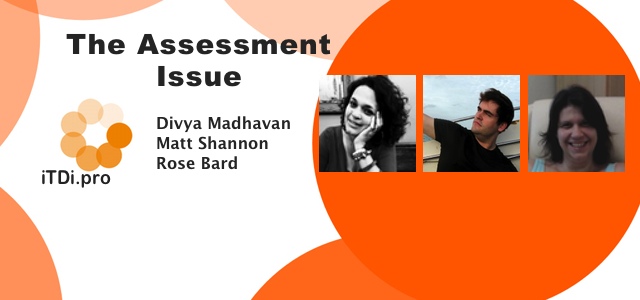
Taking the Tension Out of Test Time
– Divya Madhavan
I only give one tenth of my students’ oral exam grades. Their peers give the other nine tenths.
Does this work?
Yes
Does this work better?
I certainly think so 😉
Do they enjoy working this way?
Very much
Is it ethical?
I explain it all to them at the beginning and if anyone doesn’t want to (which does happen occasionally), we don’t do it. I only use this model of assessment if I get 100% consent from the people in the room.
Is it efficient?
Well, if you remember the kick you got out of marking stuff with a red pen when you played ‘teacher’ as a child, you might agree that students tend to put heart and soul into the process…
But… can second language learners assess each other? I mean…don’t we need a ‘proper’ teacher to pronounce the final judgment? Perhaps even a native speaker because it’s oral assessment?
Yes they can, no we don’t, and OMG native speaker supremacy? Do we really wanna open this can of worms?
What I do:
I pick a class where the assessment is low stakes, i.e. no external to prepare them for, just your average classroom with a group of people who want to boost their English and move onto the next step in their studies/jobs/lives.
I decide at the beginning how I will systematically note down information about oral skills (in my case it’s usually a little black book I write in) and make it clear that we will co-construct the assessment and most importantly, make sure everyone’s ok with this.
I write in my ’can do’ journal (what they can do in spoken English quite simply) throughout the course to give me ideas come assessment time. I devote one lesson about three quarters of the way through to writing the rubrics for assessment.
I create the assessment questions and marking scheme based on my journal and the general emergent content of the course, keeping an ear out for my ’can do’ perceptions and their ’want to do’ expectations.
We examine each student as a panel. Yes, this takes time but it’s been three years going and it’s often the most energizing moment in the course.
Why I do it:
I believe that oral assessment, when unnecessarily administered, creates huge imbalances in the human dynamics of a classroom. The teacher’s role gets inflated to the level of examiner and the student is diagnosed as the examinee, with ensuing rigmarole and protocol.
In classes where there is no real justification for assessment apart from fueling the generalizing juggernaut of accountability, outcomes and box-ticking, participatory assessment of this kind is a wonderful opportunity to empower student voices and, thus teacher voices as well by bringing course objectives back into the organic sphere of the classroom and assessing from the people up and not the system down.
Who this really works for:
Students who are bored of English classes and the malady of Cambridge past papers.
Students who hate being tested, find it causes a lot of stress in their otherwise busy and fulfillable lives.
Students who like calling teachers by their first names.
Times when it failed:
When I didn’t make it clear what we were doing at the beginning.
When I wasn’t systematic about keeping a journal and thus panicking myself when I had to assess them.
When the learners didn’t quite have the vocabulary to handle the writing of assessment rubrics, coming to an agreement in the discussions of the areas to be tested and so forth.
(By the way, I draw on as many of the languages I can function in when I teach, I don’t believe in the stoicism of an English-only law in classrooms)
Why I’ll carry on doing it:
Because I strive to be a cuddly old Freirean one day?
I saw a poster in Paris today with a picture of a bicycle and the tag was: the solution to reducing congestion and conquering obesity is rusting in your garage. It’s nice keeping things simple.
Join the conversation:
Box-ticking or mind-mapping? Questions about ELT professional knowledge – Divya Madhavan and Willy Cardoso
IATEFL Harrogate 2014, April 2nd, 5.15pm

Connect with Divya and other iTDi Associates, Mentors, and Faculty by joining iTDi Community. Sign Up For A Free iTDi Account to create your profile and get immediate access to our social forums and trial lessons from our English For Teachers and Teacher Development courses.












